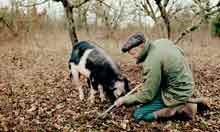The landscapes in Aquitaine can change suddenly: from rolling hills to thick woodland, and from miles of sandy beaches to sharp mountain peaks. As the scenery changes, so too does the cooking, reflecting the rich cornucopia of locally produced specialities. A tour through France's gastronomic heartland tempts you with foie gras and oysters, duck confit and blanquette de veau (veal ragout), delicious cheeses and cured hams, truffles and wild mushrooms, not forgetting some of the world's most spectacular wines. There are a host of Michelin-starred restaurants, but many of the best discoveries are made by simply stopping off for lunch in a village cafe, browsing in a rural market, visiting a ferme auberge or dropping in on a winemaker for an impromptu tasting of his latest vintage.
Dordogne

For a first taste of Dordogne, base yourself in the region's unofficial gastronomic capital, the charming medieval town of Sarlat. For centuries, townsfolk and farmers from the surrounding countryside have met at the weekly Saturday market, where little old ladies sell homemade foie gras, truffle hunters discreetly display their precious finds, and mushroom gatherers proudly lay out plump cepes, girolles or the exotically named trompettes de la mort. With your appetite whetted, the local tourism office organises gastro-tours that visit local farms, beekeepers, a 16th-century watermill producing the local speciality, walnut oil, and a day tracking down black Périgord truffles, aided by a very valuable dog called Titeuf, who is much more efficient than using the traditional pig.
Lot-et-Garonne
Named after Aquitaine's two greatest rivers, the Lot and Garonne, there is an enticing off-the-beaten-track feel to this region compared with the more well-known Dordogne. The fascinating Musée du Foie Gras in the village of Souleilles explains the complex history of this ultimate gourmet product, right back to the days of the Egyptians, and organises a colourful Fête du Foie Gras on All Saints' Day each November. The countryside here is characterised by fortified hill towns such as Tournon d'Agenais, where you can order an assiette de pays (a plate of local products) at the rustic Les Voyageurs. The assiette is heaped with products from local farms – goat's cheese, seasonal vegetables, manchon de canard (duck wings), saucisson – and this brilliant "carbon zero" initiative is promoted throughout Aquitaine. Be sure to stop off in Agen, famed for its delicious plums, pruneaux d'Agen, which have to be tasted with a glass of armagnac, another local speciality.
Gironde
Aquitaine changes personality when the majestic Gironde estuary merges into the Atlantic at the historic port of Bordeaux. Take a lazy drive through the vineyards and chateaux that produce some of the world's finest wines – Yquem, Lafite, Margaux, Mouton Rothschild – and enjoy a plat du jour in a roadside auberge, where you can feast on a giant entrecote steak from the local Bazas beef, served à la bordelaise, or a tender rack of Pauillac lamb. A very different gastronomy is on the menu as you approach the breathtaking wetlands of the Bassin d'Arcachon, where you can either visit a colourful oyster producer such as Bernard Delis, who will shuck a dozen of his oysters, or try Aquitaine caviar, responsibly farmed and reasonably priced compared to Iranian beluga.
Landes
A natural paradise of pine forests and unbroken sandy beaches, Landes is where to go for salade Landaise, a mixture of salad, locally-grown asparagus and warm, salty meat. Dozens of cafes dotted around Landes, such as the wonderful Chez Blandine in Hontanx, offer the assiette de pays, while many farms, such as La Ferme du Haza invite visitors for a gourmet "open house" – a good excuse for a long weekend of cooking courses, a market, dancing and plenty of gastronomic delights.
Pyrénées-Atlantiques
Running down to the border with Spain, the Béarn and Pays Basque offer some of the most varied cuisine in Aquitaine. The emblematic piment d'Espelette hangs over most people's doorways and this unique red pepper is a crucial ingredient in piperade, similar to ratatouille, and axoa, a rich veal stew. It even has its own festival in the town of Espelette in October. For some serious eating try la garbure, a so-called peasant's soup of cabbage, beans, potatoes, duck confit, goose gizzards, pork shank and sausage. For centuries, shepherds have farmed sheep on the Pyrénées to make the unique Ossau-Iraty cheese, perfectly complemented by homemade confiture of Itxassou cherries. And a visit to Bayonne offers foodies the pleasure of jambon de Bayonne, while chocolate production here dates back to the 15th century. The tourism office organises irresistible guided tours of the town's best chocolatiers.







